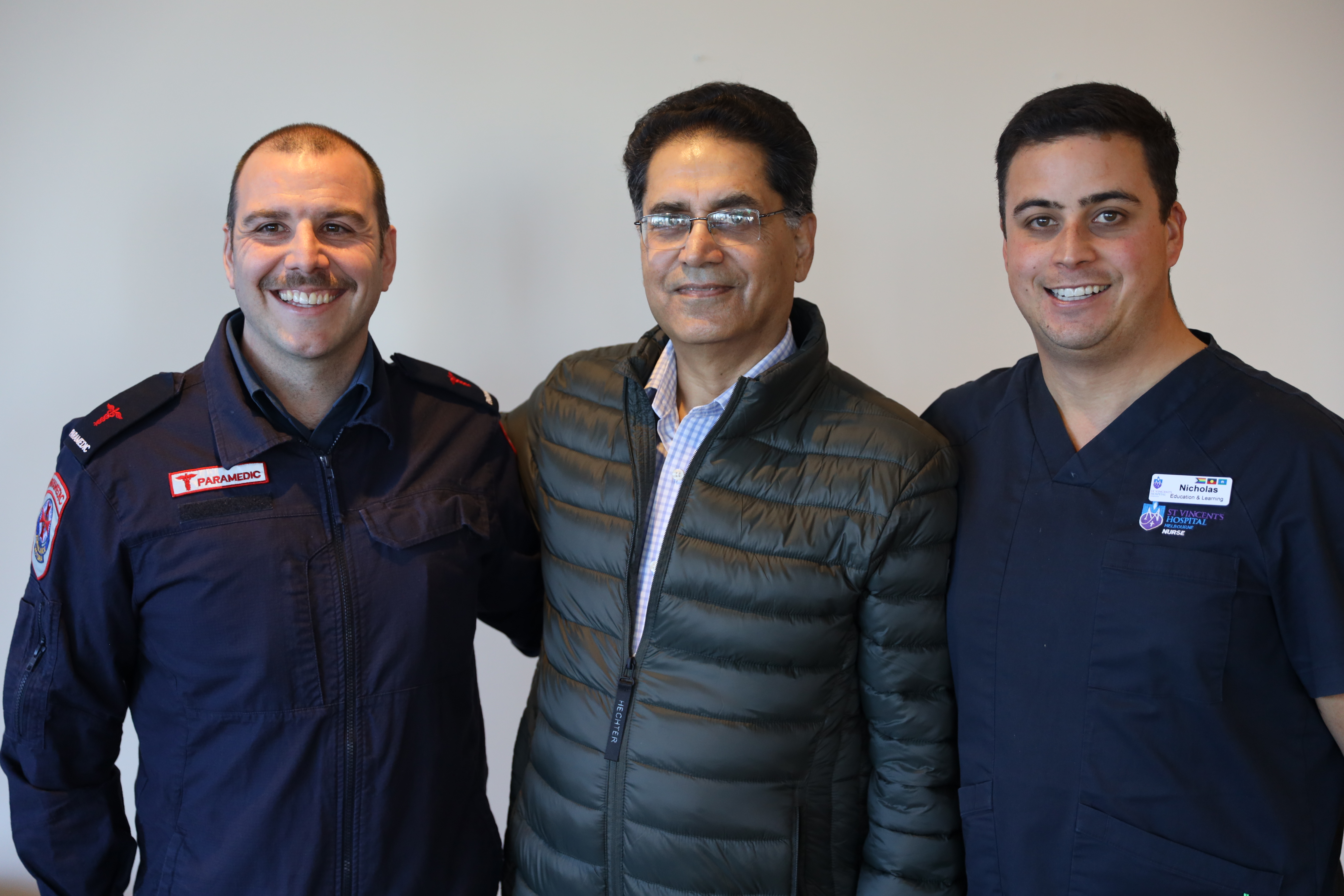Grateful for a second chance – how CPR and defibrillation saved Shakeel’s life

Pictured: GoodSAM Responder and Ambulance Victoria paramedic Ward Young, cardiac arrest survivor Shakeel Ahmad and St Vincent's Hospital Melbourne nurse Nicholas Niewoudt.
A cardiac arrest survivor has reunited with some of the first responders who came to his aid – including a St Vincent’s Hospital Melbourne nurse – to spread lifesaving messages about cardiopulmonary resuscitation (CPR) and automated external defibrillators (AED).
In February this year, 60-year-old Shakeel Ahmad suddenly collapsed at Parliament Station on his way home from work.
Bystanders, including St Vincent’s Hospital Melbourne nurses, who witnessed the incident immediately initiated the chain of survival, performing CPR and grabbing a nearby AED while Triple Zero (000) was called.
Three Ambulance Victoria (AV) staff also responded after receiving an alert on the GoodSAM app.
Shakeel received two shocks from an AED before paramedics arrived and took over, transporting him to St Vincent’s Hospital Melbourne where he stayed for nine days.
St Vincent’s Hospital Melbourne Practice Development Nurse Nicholas Nieuwoudt said receiving effective CPR and having access to early defibrillation help save Shakeel’s life and had a significant impact on how well he recovered.
“It is hard to overstate the importance of defibrillators in public spaces. They are designed to be used by people with no training,” Nicholas said.
“CPR can buy time until a defibrillator or ambulance arrives and increases the chances of survival.
“Once you know how to perform CPR, you can have a huge impact on helping somebody who really needs it.”
.JPG)
AV Metropolitan Regional Director Michael Georgiou said Shakeel’s experience was a great example of how early bystander intervention with CPR and AEDs can help save lives.
“We know about 20 Victorians have a cardiac arrest each day and only one in 10 people survive,” Mr Georgiou said.
“The quick thinking of those around Shakeel gave him the best possible shot of returning to his loved ones.
“Minutes matter in cardiac arrests, and when a patient receives CPR and a shock from an AED before paramedics arrive, their chance of survival increases by 70 per cent.”
Five months later, Shakeel said he is still recovering after receiving a coronary bypass and completing eight weeks of rehabilitation.
Meeting with his first responders from St Vincent’s Hospital Melbourne and AV, Shakeel said the experience highlighted the chain of survival.
“Everyone should know how to perform CPR and use an AED,” he said.
“I am lucky to have a second chance at life.”
Michael said Shakeel’s experience also showed how the GoodSAM app can connect patients in cardiac arrest with a nearby volunteer willing to start hands-only CPR before the ambulance arrives.
“The GoodSAM app will also guide users to the closest registered defibrillator,” he said.
“It does not require a first aid qualification and I encourage everyone over the age of 18 to sign up.”
For more information on GoodSAM visit: www.ambulance.vic.gov.au/goodSAM/
To find your nearest registered AED visit: registermyaed.ambulance.vic.gov.au/